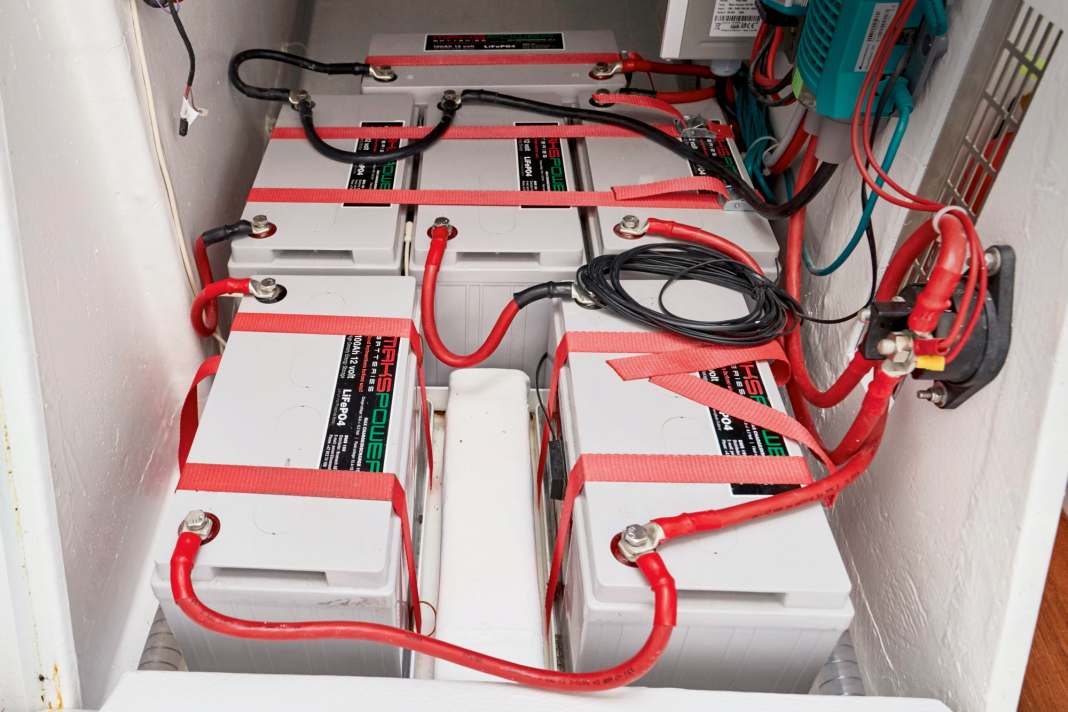Technology: Is CE conformity lost after battery replacement?



Does a yacht lose its CE conformity if the owner retrofits lithium batteries? And does this really require expensive recertification? And does this possibly entail further modifications so that the yacht can be certified according to the current standards at all? The formally correct answer is: maybe. But how did this situation come about and what does it actually mean for owners?
CE certificates for yachts are issued by so-called notified bodies. One of the largest is the International Marine Certification Institute in Brussels. YACHT spoke to IMCI Managing Director Ulrich Manigel, who has been certifying boats and yachts for over 20 years. He is a master boat builder and owner himself. Lawyer Benyamin Tanis explains the extent to which CE certification is binding for used boat owners. He specialises in legal issues relating to water sports at the law firm Tanis | von der Mosel.
More about lithium batteries:
- Batteries: How lithium batteries get through hibernation well
- Technology: Safety risk? Lithium batteries vs. iron phosphate systems
- Fire extinguisher test: How to extinguish burning lithium batteries
- Technology: How lithium batteries can be optimally charged
- Technology: When are lithium batteries suitable for starters and bow thrusters?
Interview with IMCI Managing Director Ulrich Manigel
Mr Manigel, why is there a new situation?
The situation is not actually that new. However, some interpretations have recently been formulated more clearly in discussions between the various parties involved, including and above all by the EU Commission. This has set things in motion.
What exactly is this about?
The question is what constitutes a "major conversion of a watercraft". This is because a major conversion entails a "post-construction survey". This is carried out by the Notified Bodies, with an inspector coming on board. If everything is in order, the notified body then issues a conformity report.
That sounds like a lot of officialese.
Indeed. However, this is described directly in the Recreational Craft Directive, which is part of the current legislation in Germany. Incidentally, anyone can read about this in the 10th Ordinance to the Product Safety Act (ProdSG).
So does the Recreational Craft Directive mean that if you install lithium batteries, the entire boat has to be recertified?
The whole thing is currently still under discussion. However, it is clear that the EU has once again emphasised the owner's responsibility for such conversions. Mind you, nothing has changed in the law, but it has been made very clear once again: even if the owner has not carried out the conversions themselves, but has commissioned a specialised company to do so, they are still responsible for conformity with the Recreational Craft Directive. He assumes full responsibility for placing the yacht on the market and putting it into service after the structural modification.
What exactly is the owner's role in this context?
He must carry out a risk analysis of the conversion himself. If he recognises that the conversions may have called into question the conformity with the Recreational Craft Directive, he must commission the inspection (PCA) in consultation with the Notified Body.
What standards can owners use for this assessment?
This is a good question, and we are currently in discussions with the market supervisory authorities in Germany and Belgium. It needs to be clarified with them: If you have complied with this and that during the conversion, then re-certification is probably not necessary. These discussions are currently underway, so I can't say anything concrete about this yet. However, the relevant ISO standards are a good indicator.
And what if the owner does not do the work himself, but commissions the conversion?
The specialist company carrying out the work should comply with all the necessary regulations - in the case of the lithium battery, these are EN ISO 13297:2021 and ISO 23625:2025 - and confirm this in writing. This includes, for example, cable cross-sections, fuses, short-circuit rating of the fuse, a suitable charger and an emergency switch to disconnect the battery from the DC grid.
It is important that the modifications and conversions are carefully documented and that the ship's operating instructions are adapted accordingly. Regardless of how or where it is carried out, the decision on recertification remains with the owner. This has just been clarified once again.
What happens if the owner decides that recertification is necessary?
This depends on whether the boat has already been certified under the new Recreational Craft Directive (RCD), i.e. after 18 January 2016, in which case the inspector will come on board and only check the modifications. What happens if further deviations outside the focus of the modifications are discovered is currently still being discussed. However, if the boat was certified under the first RCD from 1994, then we will probably have to carry out a complete inspection as things stand today.
"If the boat did not previously comply with the current recreational craft directive, recertification can cost more than 2,500 euros."
What does that mean?
This would mean that a boat certified in accordance with the old RCD may also have to be equipped with a means of re-entry from the water and the holding tank converted so that the three-way valve is only installed behind it. These are the main differences between the old and new directives. Unfortunately, this effort is unavoidable as the boat can only be assessed in accordance with the current Recreational Craft Directive.
What costs are incurred by the owner in both cases?
Assuming that the owner has installed new batteries and new charging technology on a yacht with a declaration of conformity in accordance with the new Recreational Craft Directive, the costs incurred by the notified body will certainly not be less than 1,000 euros plus the inspector's travelling expenses. For boats with a complete inspection, i.e. without a declaration of conformity, you can expect to pay at least 2,500 euros plus the inspector's travelling expenses.
2,500 euros is a lot of money ...
For a PCA, we have to inspect the boat, which cannot be done remotely using a camera. Then we have to check all the details, including those of the drive, document and archive them and produce a new manufacturer's plate. That's a lot of work. But yes: a few thousand euros is certainly a lot of money, especially depending on the value of the boat. Incidentally, if the inspector doesn't have to travel that far or if several owners join forces and split the travelling costs, you can save money at this point.
What happens when owners save themselves this effort?
As already mentioned, the owner is obliged to have a subsequent assessment carried out to check whether the boat still complies with the directive in the event of significant changes - if these could jeopardise conformity - and to do so before putting the boat into service. This is stated in Article 19.3 of the Recreational Craft Directive. Of course, failure to carry out this procedure is not subject to a fine. However, strictly speaking, the boat then no longer has a valid CE certification. However, whether the authorities will notice this, for example during an inspection or if the boat is sold and the new owner wants to register it, which is quite common in many EU countries, remains to be seen.
countries, remains questionable of course. And whether insurance companies check CE conformity in the event of damage is beyond my knowledge. Logically, from our point of view, in case of doubt, recertification is usually unavoidable due to the legal requirements.
If I understand you correctly, the conversion to lithium is not the only significant change. It can also be other modifications to the ship, right? When is a change substantial?
Basically, whenever the change could affect safety or environmental regulations, i.e. electrical systems, fuel systems, gas systems, drive systems, in this case the conversion to electric drive. But also when it comes to stability, because the weight or engine output changes significantly.
When did this important new regulation come into force?
As I said, this is not actually a "new regulation", but has been included in the law since 18 January 2016. However, much more attention has been paid to this in recent years. And now it has been clarified once again. This is certainly due to the greater spread of lithium batteries and the new ISO standard on lithium-ion batteries.
In road traffic, there is the ECE test mark for products that can be installed without a parts certificate or approval. Would this also be possible for lithium batteries on boats?
This is not intended for lithium batteries. Especially as the new lithium standard is not just about the battery itself, but about the entire installation that we are looking at. It's about fusing, connections, cable cross-sections, on-board storage and so on. Just looking at the actual battery would not be enough.
Can you give us an assessment of how the issue is progressing?
This is difficult because politics is always involved. It is clear that everyone involved has recognised that the regulation as it currently stands needs to be discussed further. Because it also makes the transition to electric driving more difficult, as the already expensive conversion requires an additional and expensive inspection.
On the other hand, lithium batteries on board are not entirely risk-free, especially when it comes to energy density. It is therefore important to find a good compromise between safety and cost. We at IMCI are working intensively on this. As soon as there is anything new, we will communicate it on all our channels.
The legal perspective of Benyamin Tanis

In accordance with EU Directive 2013/53/EU on recreational craft and personal watercraft, CE marking is mandatory for the placing on the market of boats between 2.5 and 24 metres in length. It confirms that the boat complies with the applicable safety, environmental and design requirements.
Conformity always refers to the condition of the boat at the time it was placed on the market. Subsequent modifications by the owner may affect the validity of the CE marking. The replacement of a lead-acid battery with a lithium system objectively entails a technical change with safety-relevant effects. It is therefore also necessary to check from a legal perspective whether the battery replacement creates new hazards that were not taken into account when the boat was originally CE-certified.
However, from a legal perspective, CE conformity is not a necessary requirement for the private operation of a boat in the EU. Private individuals may also operate boats that do not have a CE certificate.
This applies at least to the German maritime waterways and the North Sea and Baltic Sea. On our inland waterways and many German lakes, however, there is an authorisation requirement for recreational craft. In their need to base their decision on comprehensible criteria, the competent authorities occasionally require the CE conformity of the boat in question. Whether this is lawful in individual cases remains to be seen. In the case of commercial use, hire or trade, the boat must be CE-compliant. Incidentally, sales via a broker are not covered, as the broker only acts as an intermediary.

